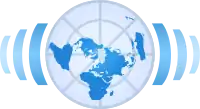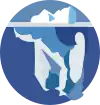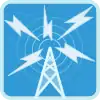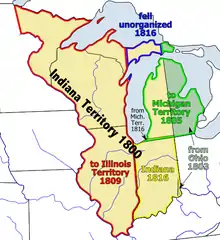Portal:Indiana
The Indiana Portal
Various indigenous peoples inhabited what would become Indiana for thousands of years, some of whom the U.S. government expelled between 1800 and 1836. Indiana received its name because the state was largely possessed by native tribes even after it was granted statehood. Since then, settlement patterns in Indiana have reflected regional cultural segmentation present in the Eastern United States; the state's northernmost tier was settled primarily by people from New England and New York, Central Indiana by migrants from the Mid-Atlantic states and adjacent Ohio, and Southern Indiana by settlers from the Upland South, particularly Kentucky and Tennessee.
Indiana has a diverse economy with a gross state product of $352.62 billion in 2021. It has several metropolitan areas with populations greater than 100,000 and a number of smaller cities and towns. Indiana is home to professional sports teams, including the NFL's Indianapolis Colts and the NBA's Indiana Pacers. The state also hosts several notable competitive events, such as the Indianapolis 500, held at Indianapolis Motor Speedway. (Full article...)
Selected article -
 Indianapolis Traction & Terminal Company's central terminal complex |
The Indianapolis streetcar strike of 1913 and the subsequent police mutiny and riots was a breakdown in public order in Indianapolis, Indiana. The events began as a workers strike by the union employees of the Indianapolis Traction & Terminal Company and their allies on Halloween night, October 31, 1913. The company was responsible for public transportation in Indianapolis, the capital city and transportation hub of the U.S. state of Indiana. The unionization effort was being organized by the Amalgamated Street Railway Employees of America who had successfully enforced strikes in other major United States cities. Company management suppressed the initial attempt by some of its employees to unionize and rejected an offer of mediation by the United States Department of Labor, which led to a rapid rise in tensions, and ultimately the strike. Government response to the strike was politically charged, as the strike began during the week leading up to public elections. The strike effectively shut down mass transit in the city and caused severe interruptions of statewide rail transportation and the 1913 city elections.
A riot that lasted four days broke out on November 2 when strikebreakers attempted to restart transit services. At its height, eight to ten thousand rioters flooded downtown Indianapolis and vandalized the city's main business district. Numerous workers, strikebreakers, policemen, and bystanders were injured. Two strikebreakers and four union members were killed. The city police were unable to control the situation and refused orders to combat the rioters as the violence worsened. After pleas for help from city leaders following continued rioting on Election Day, Governor Samuel Ralston called out the Indiana National Guard and put the city under martial law on the evening of November 5. (Full article...)Selected image -
 Mount Baldy |
Did you know -
- ... that Gleaners Food Bank has served more than 700 million pounds (320 million kg) of food in Indiana?
- ... that in 1981 Indiana State University–Evansville received a donation valued at nearly $300,000 in the form of campus radio station WSWI?
- ... that a 1963 gas explosion in Indianapolis during a Holiday on Ice show was one of the worst disasters in Indiana history?
- ... that the 1938 film Road Demon contains footage of well-known accidents that occurred at Indianapolis Motor Speedway?
- ... that during his mayoralty of South Bend, Indiana, Pete Buttigieg faced controversy when he fired the city's first African-American police chief for wiretapping?
- ... that LGBT rights activist Kit Malone helped create the first transgender organized marching group in the Indianapolis Pride Parade's history?
Related portals
Selected geographic article -
 Downtown Corydon Indiana viewed from the Pilot Knob in the Hayswood Nature Reserve |
Selected biography -
 Schulz at Michigan in 1907 |
Adolph George "Germany" Schulz (April 19, 1883 – April 14, 1951) was an All-American American football center for the University of Michigan Wolverines from 1904 to 1905 and from 1907 to 1908. While playing at Michigan, Schulz is credited with having invented the spiral snap and with developing the practice of standing behind the defensive line. As the first lineman to play in back of the line on defense, he is credited as football's first linebacker.
During his time at Michigan, Schulz also became involved in one of college football's earliest recruiting controversies, as some suggested that he was a "ringer" recruited by Michigan coach Fielding H. Yost. Schulz was 21 years old when he enrolled at Michigan and had worked in an Indiana steel mill and reportedly played for either amateur or professional teams. Michigan was refused re-entry into the Western Conference in 1908 when it insisted on playing the 25-year-old Schulz for a fourth season in violation of conference eligibility rules. (Full article...)Selected quote
General images
Topics
- Economy: AM General - ATA Airlines - Casinos - Cummins - Delta - ITT - JayC - Lilly - Limestone - Manufacturing - NiSource - Shoe Carnival - Simon Property Group - Soybeans - Studebaker - Vectren - WellPoint
- Education: Elementary schools - Middle schools - High schools - Private schools - School districts - Colleges and universities - E-Learning - ISTEP
- Geography: Caves - Lakes - Rivers - State forests - Watersheds
Categories
Attractions
 What would become Indiana Dunes State Park in 1916 |
Recognized content
| This is a list of recognized content, updated weekly by JL-Bot (talk · contribs). There is no need to edit the list yourself. If an article is missing from the list, make sure it is tagged (e.g. {{WikiProject Indiana}}) or categorized correctly. See WP:RECOG for configuration options. |
Good articles
- 1963 Indiana State Fairgrounds Coliseum gas explosion
- 2006 Brickyard 400
- 2011 South Bend mayoral election
- 2015 South Bend mayoral election
- 2019 South Bend mayoral election
- 2021 NCAA Division I men's basketball championship game
- The Fault in Our Stars (film)
- Hurley Goodall
- Proposed new South Shore Line station in South Bend
- WCAE
Featured pictures
 Kenje Ogata 1943
Kenje Ogata 1943 US-NBN-IL-Lebanon-2057-Orig-1-400-C
US-NBN-IL-Lebanon-2057-Orig-1-400-C
WikiProjects
![]()
- US-related WikiProjects
- Indiana
- Indiana State Roads
- Indianapolis
- Indiana
State facts
Indiana | |
|---|---|
| Country | United States |
| Admitted to the Union | December 11, 1816 (19th) |
| Capital | Indianapolis |
| Largest city | Indianapolis |
| Largest metro and urban areas | Indianapolis-Carmel MSA |
| Government | |
| • Governor | Eric Holcomb (R) (2017) |
| • Lieutenant Governor | Suzanne Crouch (R) (2017) |
| Legislature | Indiana General Assembly |
| • Upper house | Senate |
| • Lower house | House of Representatives |
| U.S. senators | Todd Young (R) Mike Braun (R) |
| Population | |
| • Total | 6,080,485 |
| • Density | 169.5/sq mi (65.46/km2) |
| Language | |
| • Official language | English |
| Latitude | 37° 46′ N to 41° 46′ N |
| Longitude | 84° 47′ W to 88° 6′ W |
Things you can do
 |
Here are some tasks awaiting attention:
|
Associated Wikimedia
The following Wikimedia Foundation sister projects provide more on this subject:
-
 Commons
Commons
Free media repository -
 Wikibooks
Wikibooks
Free textbooks and manuals -
 Wikidata
Wikidata
Free knowledge base -
 Wikinews
Wikinews
Free-content news -
 Wikiquote
Wikiquote
Collection of quotations -
 Wikisource
Wikisource
Free-content library -
 Wikiversity
Wikiversity
Free learning tools -
 Wikivoyage
Wikivoyage
Free travel guide -
 Wiktionary
Wiktionary
Dictionary and thesaurus
-
 List of all portalsList of all portals
List of all portalsList of all portals -
 The arts portal
The arts portal -
 Biography portal
Biography portal -
 Current events portal
Current events portal -
 Geography portal
Geography portal -
 History portal
History portal -
 Mathematics portal
Mathematics portal -
 Science portal
Science portal -
 Society portal
Society portal -
 Technology portal
Technology portal -
 Random portalRandom portal
Random portalRandom portal -
 WikiProject PortalsWikiProject Portals
WikiProject PortalsWikiProject Portals





.jpg.webp)


























.JPG.webp)

